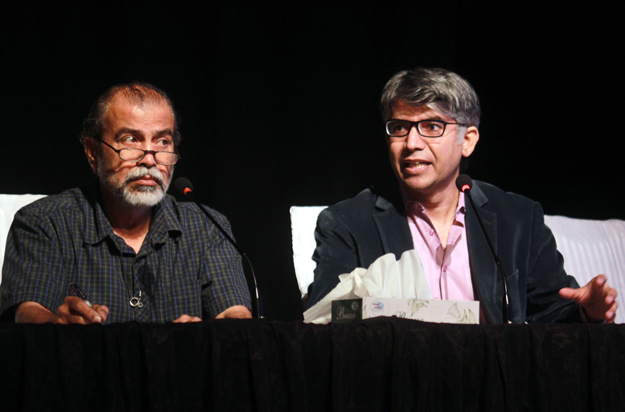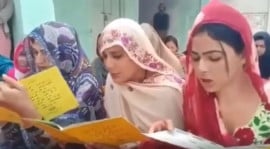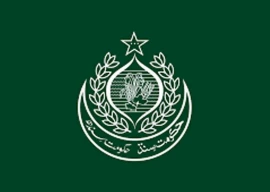The session started with the screening of a short video covering the history and archiving procedures of the Sindh archives. The video showed the audience that a major part of the records at the Sindh archives are handwritten. For preservation, the historical documents are fumigated for 48 hours, cleaned through special procedure and chemically treated so that they can last longer.
Filmmaker Babar Sheikh spoke about the portrayal of Karachi's architecture in films and popular media. He spoke about places such as Habib Fida Ali House and Frere Hall, which have been used extensively as filming locations.
'EIA public hearings have become a meaningless formality
Rivers and urban flooding
Researcher Gul Hassan Kalmatti's discourse on the rivers, nullahs and tributaries in Karachi prompted many comments from the audience, as it touched upon the issue of urban flooding in the city after the rain.
Kalmatti mentioned that there were three major rivers in Karachi - the Lyari River, Malir River and Hub River - of which the Hub River was located on the city's western border. All the three major rivers along with many minor nullahs flowed directly into the Arabian Sea.
Due to encroachments and the establishment of new housing societies without due planning, natural drains of Karachi are not finding their way out to the sea and this results in flooding, Kalmatti pointed out.
There are 29 tributaries of the Malir River, 13 of the Lyari River and 17 of the Hub River, the researcher said, adding that many of them have been rendered ineffective due to poor planning and encroachments.
The soul of the city has lost its charm
Kalmatti discussed the Gujhro Nullah that drains into the Lyari River, which nowadays is being called 'Gujjar Nullah' in vernacular. "I do not understand why we have started calling it the Gujjar Nullah instead of Gujhro Nullah," the researcher bemoaned. To justify this misnomer, someone even wrongly claimed that it was named after the Gujjar tribe, he said, adding that gujhro means to intrude secretively and the nullah was called gujhro as people could not identify its water source, imagining that the water entered the nullah secretively.
The researcher also discussed the flooding of Saadi Town. "There is no link between Thaddo Dam and Saadi Town. The media connects them erroneously," he claimed, adding that a significant portion of Saadi Town has been built over a nullah, which has stopped the natural flow of rainwater in the area, causing flooding.
In a bid to maximise land for plotting, the land developers decrease drain widths and do not leave space on their sides, Kalmatti lamented.
 Dr Kaleemullah Lashari (left) and Dr Hafeez Jamali (right) discussing the presentations delivered at the session. PHOTO: ATHAR KHAN
Dr Kaleemullah Lashari (left) and Dr Hafeez Jamali (right) discussing the presentations delivered at the session. PHOTO: ATHAR KHANHindu amils
The last video shown at the session was sent by Indian journalist Raaz Aggarwal who later joined the session through video link. The video discussed Hindu amils of Karachi.
Karachi, and its issues, not a new phenomenon
Amil means bureaucrats and the video discussed the rise of the Hindu elite in Sindh. They were formerly associated with the Talpurs and later joined the bureaucracy, holding high ranks during colonial rule. Their families enjoyed luxurious lives in Karachi and Hyderabad until Partition disrupted their lives and they had to leave for Mumbai.
Aggarwal's video included oral interviews of some of the descendants of Hindu amils and photographs depicting their rich lifestyles. She pointed out that male members were wearing imported suits in photographs while women were draped in embroidered saris in the Parsi style.
The video also highlighted the contributions of Hindu amils towards education and healthcare in Sindh. Rupchand Bilaram, who served as judicial commissioner of Sindh, founded a school in Karachi which is now called the Government College for Women, Aggarwal claimed.
Dr Hafeez Jamali and Dr Kaleemullah Lashari also spoke at the session.
1731588327-0/BeFunky-collage-(59)1731588327-0-405x300.webp)
1731587470-0/lady-gaga-(2)1731587470-0-165x106.webp)

1727341229-0/diddy-(13)1727341229-0-165x106.webp)
1731584966-0/diddy-(43)1731584966-0-165x106.webp)












COMMENTS
Comments are moderated and generally will be posted if they are on-topic and not abusive.
For more information, please see our Comments FAQ